10.23.2018 | 11:38 am
A note from Fatty: Be sure to read part 1 before you read this part.
Melisa and Lisa had gone. They were going to be running around Turquoise Reservoir, coming back across the road in eight miles or so.
Which gave me plenty of time, I figured, to go pack up Lisa’s and my stuff at our hotel, check out, and then go get Blake and Jeff. We’d then be able to meet them and cheer them on at several more points on the way to the finish line.
I hustled, picked everyone up, and got to where we expected to see them. And no sooner had we started looking up the trail for them than they came running out:
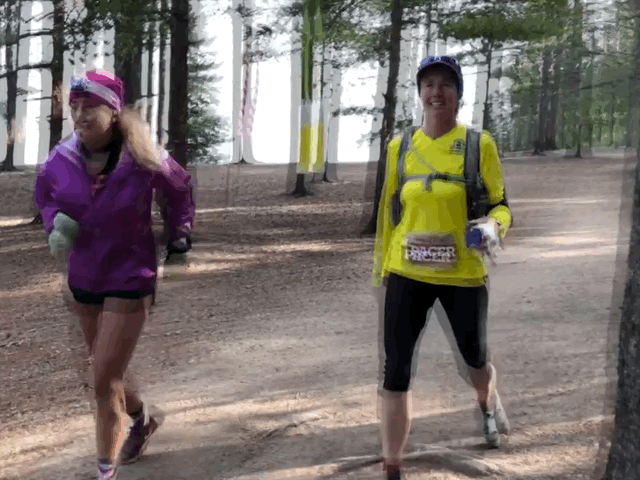
Melisa was smiling! And moving at the pace — as you can see — of a fast walk! And she was there minutes sooner than we had expected her.
She was 95 miles (my guess) into this race, and moving as fast as she needed to.
Everyone’s spirits soared.
“We’ll see you soon!” we cheered as they crossed the reservoir road and started down the other side.
But by the next time we saw her, things had changed. A lot.
Down
We had to drive a little bit of a circuitous route to get to the dirt road that connected to where we’d see them again, but I’d stopped worrying.
Then we saw Melisa, and everyone started worrying again.
The happy, still-sort-of-running Melisa was gone, and in her place was the suffering, every-step-is-agony Melisa.
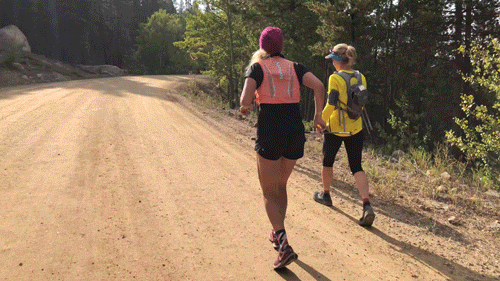
The short-but-steep downhill had been a last straw of sorts for Melisa’s feet.
Still, we walked with the two of them, cheering them on. Staying positive. Being encouraging.
“YOU AREN’T HELPING,” Melisa said. “I can tell that you’re all just walking, so GO.”
Banished, we left Lisa and Melisa to their misery. We’d have to content ourselves with tracking them on Lisa’s phone’s Find-a-Friend.
At the Top of the Boulevard
We drove to the top of the Boulevard — where the dirt meets the road, signaling you’re in the homestretch of the race — and waited. Occasional runners would come by, all of them a mix of pain and elation. Each time one came by, we’d cheer and the course marshal — carrying a bongo drum — would hammer out an awesome beat.
I took turns looking at my watch, looking at Lisa’s dot on Find-a-Friend — willing her to reach the turn that meant they were on the 2-mile-long Boulevard climb — and answering the dozens of texts coming in from family and friends, asking about how Melisa was doing.
From time to time, I’d text Lisa, asking how things were going, and then I’d relay her reply to everyone with me.
This was my first experience being an anxious racer crew, but I’m pretty sure I made up for a lifetime of it in the hour (or two? or ten?) we stood there.
Rejoining
It’s tough to watch a dream fade.
As time went by we went from, “She’ll get it” to “She has a chance” to “Who cares about time? The distance is what matters.”
10:00am — the official finishing time — came and went.
The bongo drum-playing course marshal apologetically said, “I have to go help with course cleanup,” and left.
Lisa’s blue dot was at the bottom of the boulevard; it was difficult to tell whether it had moved in a while.
I was looking at it when Lisa texted me, “We’re going to be a while.”
I texted back, “Is it OK for us to come down and walk up with you?”
She replied, “Melisa says it’s OK.”
We all started walking down, except Jeff, who broke into a run. Which was adorable.
The Walk
We caught up with Melisa and Lisa and began walking with her. 10:00 had come and gone, and 11:00 — the time racers need to hit to get their name on the official finishers’ list — was coming up fast.
Nobody mentioned time.
Sometimes we tried to talk; most of the time we were quiet.
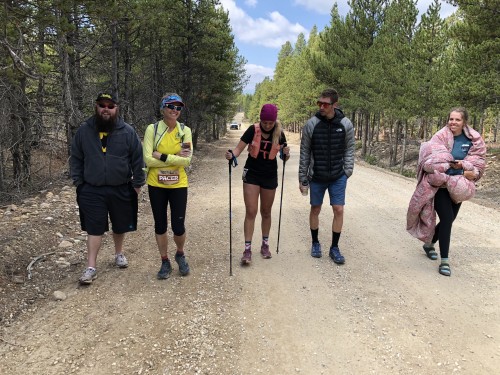
Lisa would ask, every few minutes, if Melisa wanted something to eat, or something to drink. After one of these questions, Melisa said, “YOU’RE NOT DOING A GOOD JOB OF PACING ME. EVERYONE ELSE PACED ME BETTER THAN YOU.” I started laughing, then realized Melisa wasn’t making a joke.
Lisa looked hurt, but could tell it was just pain talking.
Melisa would take a step, plant her poles, then take another step. Baby steps. Not quite one mile per hour.
Roughly one zillion people were texting me, asking what was going on. I did my best to keep up. Later, Melisa would tell me that her main memory of me from the day was that I was just texting all the time.
But I wasn’t just texting. I was also taking pictures.
At which point she tried to do her usual smile-for-the-camera smile. “Cut it out,” I said. “Just ignore the camera.”
And then I got the best, most honest pictures of Melisa you could ever see.
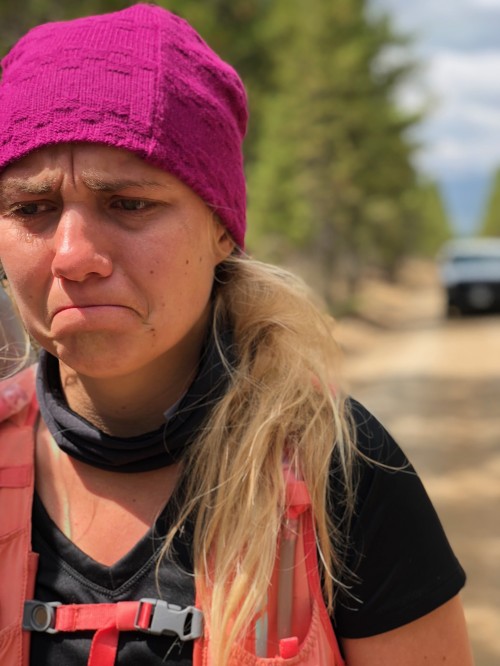
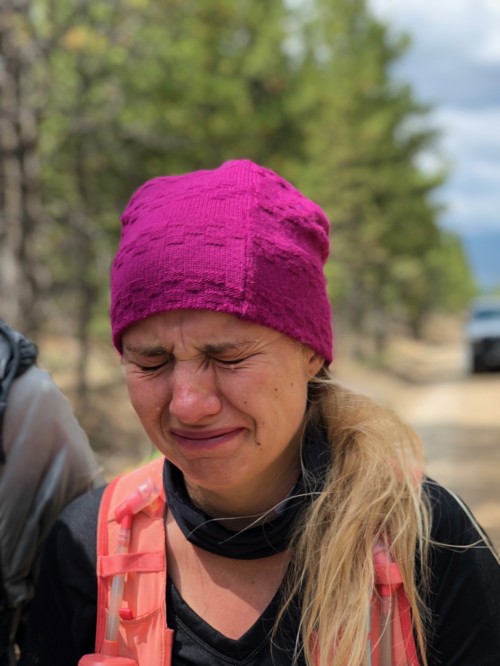
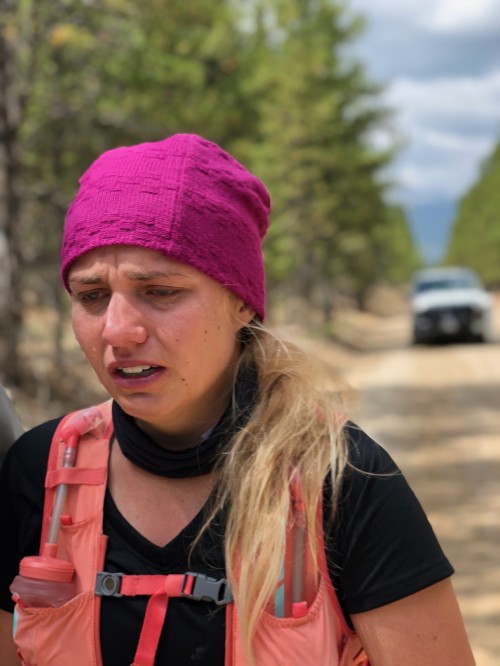
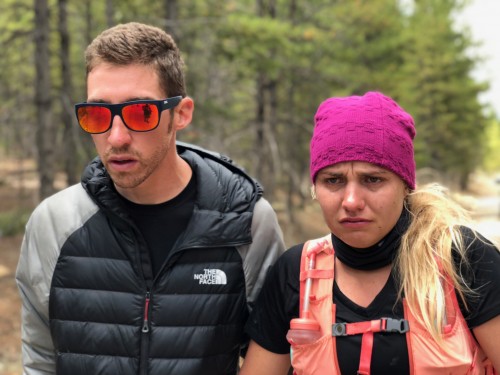
That’s what giving everything you’ve got, and then going way beyond that, actually looks like. It hurts like hell and it’s no fun at all.
And it doesn’t — at least at the moment — feel glorious or brave or extraordinary. The people around you might see it, but you don’t see or feel it yourself.
The Finish Line
Something you probably didn’t notice in those photos is the white truck in the background. That’s the EMT truck. The sweep truck. It stayed a respectful 50 feet behind Melisa for close to three hours while she walked the two miles up the Boulevard. Though it did pull up once when Melisa stumbled. “If she can’t stay upright on her own I need to pull her,” the woman said.
A fair demand.
So Melisa kept walking. Slower, but still going. I looked at my watch and saw it was 12:30. So the awards ceremony was going on. Who cares.
The woman in the truck pulled up and said to Lisa and me — not in earshot of Melisa — “You should know that the timing mat and finish line arch and the bleachers have been taken down. The street’s open. She’s doing this strictly out of her own determination.”
We understood. That had been true for a while.
But Melisa was going slower. She was still moving forward, but so slowly now. You couldn’t walk that slow if you tried. And she still had about 2/3 of a mile to go, even once she reached the pavement.
I couldn’t imagine her walking that much further. I just couldn’t. She was making walking motions, but she wasn’t really moving.
And then a truck pulled up. It was a man from Life Time.
He walked up to Melisa and said, “Everyone knows this race is more than 100 miles. You’ve gone 100 miles, and this is your finish line. You’ve finished this race.”
And he gave her a bouquet of flowers, and a finisher’s medal. And a hug.
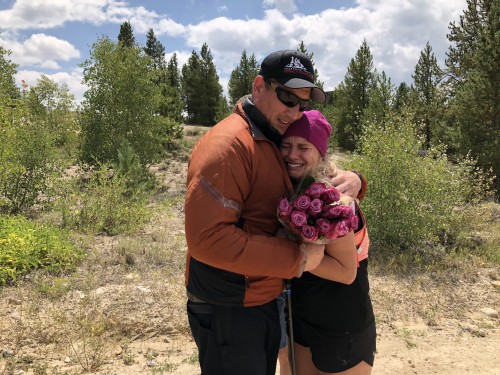
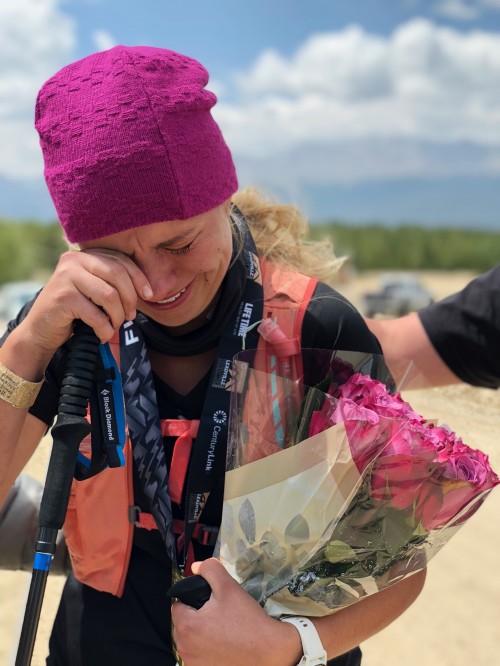
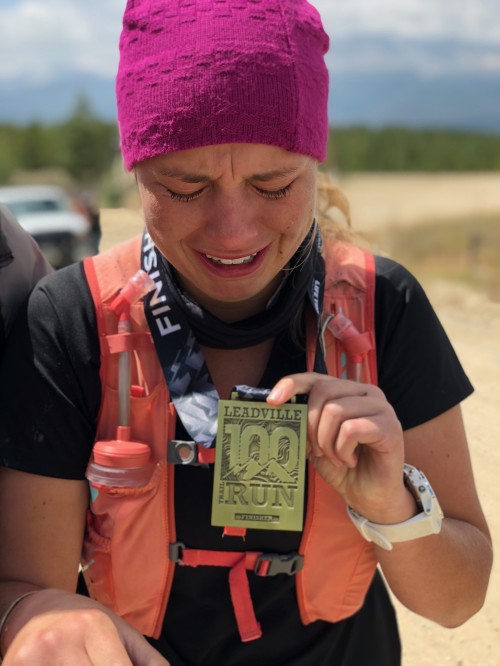
The Leadville 100 Trail Run results page shows Melisa as making it to the Mayqueen checkpoint, but not the finish line. The 2018 Leadwoman results page doesn’t show her at all.
Which goes to show, results pages don’t know shit.
Comments (36)
10.22.2018 | 3:03 pm
A couple weeks ago, The Hammer and Melisa did a local endurance run/race together: The Corner Canyon Ultra Trail Run.
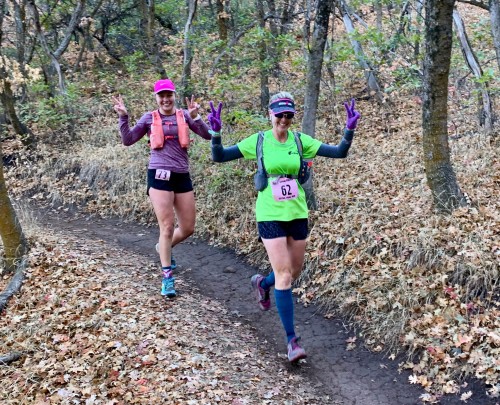
They did the 50K together, and had an awesome time. Although there was a photobomber who managed to get into the frame of one of the official photos:
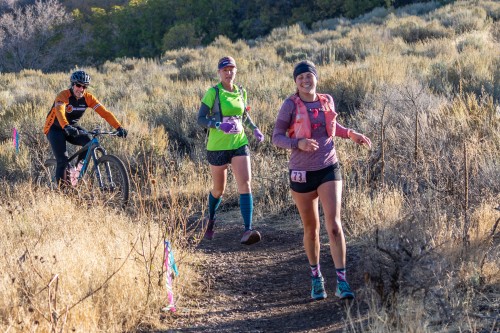
Lame.
Anyway, even after doing this incredibly tough run, they were both happy and strong and feeling great.
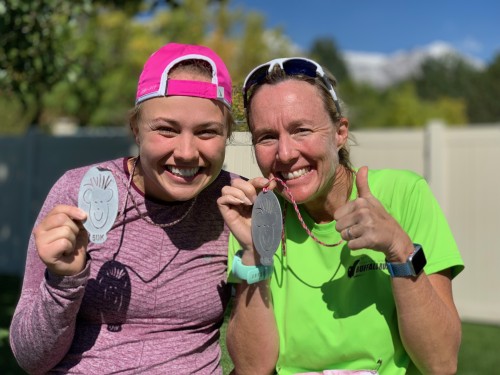
This post is not about that race. Because what would I even say beyond what I just said?
This post is about another run, one which I also witnessed only as a spectator.
But for this race, wow. I’ve got a story. And some photos.
And I’m pretty sure you’re going to cry at the end of it.
The Setup
Immediately after the 2017 Leadville 100 (like, while we were still in the finish line area), Melisa told us she wanted to race the Leadwoman in 2018. We weren’t really surprised; it had been on The Hammer’s bucket list for a long time, too.
For those of you who aren’t familiar with the Leadwoman / Leadman, it’s not a single race. It’s a series of races. You have to complete the Leadville Trail Marathon (in June), the Silver Rush run and/or mountain bike race (July), the Leadville Trail 100 MTB race (2nd Saturday of August), the Leadville 10K (day after the Leadville 100 MTB), and the Leadville Trail 100 run (1 week after the LT100 MTB race).
And through the summer, Melisa had done all of them, right up to the Leadville Trail 100 run. In fact, on the starting line of the Leadville 100 trail run, she was the second-place woman in the series and set up to be the youngest woman to ever complete the Leadwoman.
The Hammer and I came up to Leadville (even though we had just left it a few days earlier) to crew for her and cheer her on.
Melisa had started strong, building up a nice buffer in the first forty miles of the race, going into the Twin Lakes aid station. She was happy and excited for the next twenty miles, which played to her strengths: speed-hiking and climbing.
After she left the aid station, we went back to town, went on a fun mountain bike ride together, got a pizza, and everyone else went back to Twin Lakes while I went back to the hotel room to do some work stuff I was behind on, and to text updates to everyone of Melisa’s progress according to the inReach Mini she was carrying (you could get and send text messages from the aid station, but that was about as connected as the place got).
At first, things seemed fine. I got lots of Powerpointing done and texted occasional updates to Lisa, Blake, and Jeff (Melisa’s boyfriend).
Then it seemed like her dot slowed down. A lot. And it took a long time for her to get to the turnaround timing mat.
I stopped getting any work done and just sat there at the computer, texting Lisa and constantly refreshing the GPS page (not that this did any good, because the tracker sends a ping only once every ten minutes or so).
But Melisa did it. She came back into the Twin Lakes aid station with about 20 minutes to spare before the time cut would sweep her off the course. It had been a harder segment than she’d expected, which seemed natural. This was the first time she’d done more than fifty miles, so how could she have known what to expect?
She took off with her pacer, determined to finish the final forty miles of this race.
The Hammer came back to our hotel and we went to bed, not bothering to set an alarm; we weren’t slated to be on duty again ’til the final five miles of the race, when Lisa would be pacing her.
And that’s where my story begins.
Wake Up
At three in the morning, more or less on the nose, Lisa suddenly woke up, her mommy spidey-sense on full alert. She looked at her phone. Nothing.
One second later, she got a text. She read it and said, “Wake up.”
“I’m already awake,” I said. “What does the text say?”
“It’s from Blake,” Lisa said. “Melisa wants me to crew for her at the last aid station and pace her for the last 13 miles.”
“I wonder what changed,” I said, but didn’t really wonder. Melisa was suffering and wanted her mom. The single most natural thing in the world, really.
The Hammer was up, putting together a camelbak and running clothes.
“I don’t know what to give her at the aid station,” I said. “We weren’t planning on this.” Frankly, I was dismayed at how unprepared I suddenly felt. I’m used to being crewed for, not for doing the crewing. And I don’t know anything about crewing for runners. And we hadn’t been given any instructions on what Melisa wanted or expected from her crew.
So we threw together everything we had with us, foodwise (a fair amount; Lisa had brought along quite a bit of just-in-case gels and chews and drinks and stuff) and headed out to the Mayqueen aid station, 87 miles into the race.
Yellow Pants
You know how there are certain moments in your life that feel like they’re going to stick in your head forever? I had one of those at Mayqueen. We had to park far away from the aid station itself, due to the long line of cars along the road, where other crews had parked their cars. It was 5:30 in the morning and The Hammer and I were worried we weren’t going to get to the aid station before Melisa did. So we ran, each of us carrying one handle of the plastic bin we had thrown together with food and clothes we’d put together for Melisa.
It was very dark. And cold. And foggy. And there was a tense urgency we were both feeling, up against the scrambled-brain background that too little sleep brings.
We got to the aid station at 5:55am. Lisa checked and found Melisa hadn’t come through yet. So that was a good thing.
Except of course it wasn’t. She only had five minutes ’til the cutoff, which meant she was cutting it very close.
No, wait. We’d gotten our numbers wrong. The cutoff time for this aid station was 6:30am. Melisa still had more than half an hour until the cutoff.
We unpacked what we brought close to the tent, figuring Melisa would want to go in and warm up for a minute, then stood waiting, staring up the road, willing Melisa to come running toward us. Unable to know how close she actually was, since the inReach tracker battery had evidently died during the night.
After a few minutes, I couldn’t bear to just stand there anymore. “I’m going to walk up the road a little,” I told Lisa. “That way when Melisa gets close I can flag her down and guide her over to where you are so she won’t have to pick you out of the crowd.”
I walked toward the start of the aid station lane, peering forward, hoping the next person I’d see would be Melisa. Noticing that every single person standing on both sides of the road was also staring toward the intersection in the road, also willing their runner would be next.
I got to the turn, where the course turned left off the road and into the aid station lane. I looked at my watch. 6:15.
For the next little eternity, there would not be a single minute that would go by without me looking down at my watch. To be more accurate, there would not be a half minute that would go by without me looking down.
6:24. There are now markedly fewer people in the aid station lane than when I got here. No longer a crowd. Just worried crews.
6:25. I’m starting to prepare my “87 miles is incredible” speech. It’s a short speech (in fact, that’s the whole speech), because I know I wouldn’t want to hear a long speech if the circumstances were reversed.
6:26. I’m really going to have to give that speech, aren’t I? I don’t want to give that speech. I’m just not going to say anything. She doesn’t need to hear me say anything.
6:27. A woman in yellow rain pants comes up and tells the few of us staring up the road, “I’m going to start walking toward the timing mat. I’m going to walk very slowly, but your racers have to get across the mat before I do to continue racing.
And she starts walking. Very slowly. Backwards. Stopping sometimes for seconds at a time. I can tell that she doesn’t want to get there before anyone.
6:28. I hear them before I see them, but only by a second or two. There’s Melisa and her pacer. Her pacer is yelling encouragement, is being amazing.
And Melisa is sobbing. Crying out loud. Her arms are swinging like she’s running, her legs are moving like she’s walking on glass.
I join them, stealing frequent looks at my watch. “See the woman in yellow pants? She’s the course marshal. you need to get across the timing mat before she does. Then we’ll take care of you and you can finish this race.”
6:29. We’re catching up to the slow-walking woman in yellow pants, but it is going to be close.
Not the End
With fifty feet to go, Melisa passes the woman in yellow pants. I will remember this moment forever. Melisa has no recollection of this instant.
Melisa crosses the timing mat. I am staring at my watch as she does so. It’s 6:31, technically past the time cutoff. But nobody steps over to tell Melisa she’s done, so we busy ourselves in feeding her, warming her, asking her if she wants different shoes, different socks, anything. And it’s not just Lisa and me doing this; a crowd (OK, two more people) of Melisa’s friends and Melisa’s pacer are joining in.
A few minutes later, Lisa and her daughter head out. They have just under 3.5 hours to run just over thirteen miles. Ordinarily, that would be enough time for Melisa to run twice that distance.
But “ordinarily” is far, far behind her.
And that’s where I’ll pick up in the next (and I expect last) installment of this story.
Comments (5)
10.10.2018 | 8:39 am
I put my entire summer into training for this endurance race. I hired a coach and followed her plan. I came out and got comfortable with the course, several times.
I researched equipment and practiced with it until I was confident in my choices. I did the same with food, getting comfortable with what I’d eat during which parts of the race, and how often.
I planned out every mile; I wrote down and memorized my course of action for every contingency.
I visualized myself crossing the finish line. Oh, more than anything else, I visualized myself crossing that finish line.
And then, about forty miles into this event, I more or less jettisoned all of that nonsense I concocted before the race, because now this race is now.
Oh, I was such a fool up until this race got hard. If only I had been as wise then as I am now — specifically, now that I’m exhausted, trailing my projected split times, cramping, and generally demoralized.
I see everything so much more clearly now.
OK, if I’m going to be completely honest, I actually started having race-moment epiphanies right from the starting line. Sure, I had been told to not go hot off the starting line, but dammit I felt great. “Why shouldn’t I allow the possibility of having an exceptional day to play out?” I asked myself. “Maybe this is the day I completely shatter all expectations. Maybe today is the day I discover that I can fly forever.”
It was also during this race that I discovered that I am stronger than everyone around me, and that if my group is going to have a fast day it’s up to me to set the pace. Which meant pulling for about an hour and a half. These guys were lucky to have me, and it was a disgusting show of poor sportsmanship when they surged ahead and dropped me when I pulled around to let them take over for a bit.
Oh, there’s that stupid “Eat” chime on my GPS I arrogantly set to go off every thirty minutes. That thing is so annoying. I know when I’m hungry and when I’m not, and right now I am not. In fact, the very idea of food is utterly repellent to me right now, and has been for about two hours. My stomach feels terrible and I hate the very idea of GU right now; it completely makes me gag. I don’t know how I managed to choke it down every half hour during long training rides the whole summer.
All of that, though, is just a bunch of little examples. They’re almost beside the point.
The thing I’ve actually truly learned about myself during this race is that racing is not what I love doing. I love endurance riding, not endurance racing. When you’re out riding for hours on end, you’re self-supported, going at your own pace, with people instead of against them, enjoying the beauty of the ride and the perfection of being alone with your bike.
Endurance racing is just a vain mockery of everything that’s pure and perfect about endurance cycling.
And then there’s my crew. My family, my friends. They’ve traveled a great distance and used their precious vacation days to come see me…and I’m hardly even seeing them at all today. I’m into the aid station, grabbing something, barking instructions at these wonderful people like I’m some kind of angry ingrate, and then I leave them.
That’s messed up.
They came to see me, I should be with them.
I don’t know what I’m even doing out here. This isn’t proving anything to anyone, I’m not having fun, it isn’t the kind of riding I love to do, and I’m not with the people I love. I’m ending this race as soon as I get to the next aid station.
I understand everything so much more clearly now.
Comments (22)













